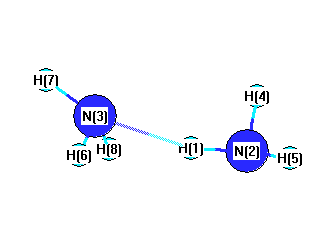Vibrational Frequencies calculated at HF/6-311+G(3df,2pd)
| Mode Number |
Symmetry |
Frequency
(cm-1) |
Scaled Frequency
(cm-1) |
IR Intensities
(km mol-1) |
Raman Act
(Å4/u) |
Dep P |
Dep U |
|---|
| 1 |
A' |
3815 |
3456 |
10.05 |
|
|
|
| 2 |
A' |
3803 |
3446 |
46.21 |
|
|
|
| 3 |
A' |
3692 |
3345 |
0.94 |
|
|
|
| 4 |
A' |
3681 |
3335 |
22.11 |
|
|
|
| 5 |
A' |
1790 |
1622 |
13.49 |
|
|
|
| 6 |
A' |
1783 |
1615 |
22.41 |
|
|
|
| 7 |
A' |
1128 |
1022 |
107.21 |
|
|
|
| 8 |
A' |
1121 |
1015 |
257.94 |
|
|
|
| 9 |
A' |
331 |
300 |
41.31 |
|
|
|
| 10 |
A' |
102 |
92 |
22.01 |
|
|
|
| 11 |
A' |
58 |
52 |
78.11 |
|
|
|
| 12 |
A" |
3817 |
3459 |
8.49 |
|
|
|
| 13 |
A" |
3815 |
3457 |
3.25 |
|
|
|
| 14 |
A" |
1805 |
1636 |
17.74 |
|
|
|
| 15 |
A" |
1788 |
1620 |
17.76 |
|
|
|
| 16 |
A" |
212 |
192 |
59.02 |
|
|
|
| 17 |
A" |
94 |
85 |
37.31 |
|
|
|
| 18 |
A" |
29 |
26 |
10.11 |
|
|
|
Unscaled Zero Point Vibrational Energy (zpe) 16432.2 cm
-1
Scaled (by 0.906) Zero Point Vibrational Energy (zpe) 14887.5 cm
-1
See section
III.C.1 List or set vibrational scaling factors
to change the scale factors used here.
See section
III.C.2
Calculate a vibrational scaling factor for a given set of molecules
to determine the least squares best scaling factor.
Charges, Dipole, Quadrupole and Polarizability
Charges from optimized geometry at HF/6-311+G(3df,2pd)
Charges (e)
| Number |
Element |
Mulliken |
CHELPG |
AIM |
ESP |
| 1 |
H |
0.152 |
|
|
|
| 2 |
N |
-0.269 |
|
|
|
| 3 |
N |
-0.200 |
|
|
|
| 4 |
H |
0.060 |
|
|
|
| 5 |
H |
0.060 |
|
|
|
| 6 |
H |
0.078 |
|
|
|
| 7 |
H |
0.059 |
|
|
|
| 8 |
H |
0.059 |
|
|
|
Electric dipole moments
Electric dipole components in Debye
(What's a Debye? See section
VII.A.3)
| |
x |
y |
z |
Total |
| |
0.789 |
-1.901 |
0.000 |
2.058 |
| CHELPG |
|
|
|
|
| AIM |
|
|
|
|
| ESP |
|
|
|
|
Electric Quadrupole moment
Quadrupole components in D Å
Polarizabilities
Components of the polarizability tensor.
Units are
Å
3 (Angstrom cubed)
Change units.
| |
x |
y |
z |
| x |
0.000 |
0.000 |
0.000 |
| y |
0.000 |
0.000 |
0.000 |
| z |
0.000 |
0.000 |
0.000 |
<r2> (average value of r
2) Å
2
| <r2> |
77.963 |
| (<r2>)1/2 |
8.830 |
